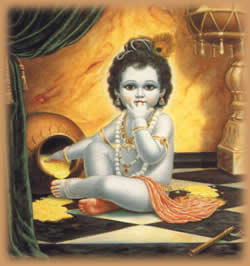In
the house of Vasudeva
will
the Supreme Lord,
the original transcendental person, personally appear...
Bhagavata Purana, 1.23

Baby Krishna
‘Krishna’ means black in Sanskrit and many statues of him are of a black or dark skinned figure; early pictorial representations also generally show him as black. However, by the nineteenth century, he almost always appears blue, and even today, although there are a number of theories, no-one really knows why he has ended up this colour.
dark
joy baby, born under threat
mischievous and playful...ordinary and astonishing
To most Hindus*, Krishna is an avatar (incarnation) of the great god Vishnu. In the Bhagavad Gita** he is the vehicle for the revelation of ultimate reality; at the other end of the spectrum he is known for his childhood pranks, erotic seductions and for inspiring the heady rapture of personal devotion.
According to the Bhagavata Purana†, the province of Mathura was in the thrall of the tyrannical king Kansa, who was told that the eighth child of his cousin Devaki would be responsible for his death. Enraged, he was about to slay his cousin, when her husband Vasudeva intervened, promising to deliver all their children into Kansa’s hands, if only he would spare Devaki.
Kansa imprisoned Devaki and Vasudeva, and murdered their first six offspring. The seventh, Balarama, was miraculously saved, and the eighth was Krishna, who was rescued and delivered into the hands of Vasudeva’s friends, the cow herders Nanda and Yashoda. He was born on the eighth day of the month of Shravan; the festival celebrating his birth, Janamashtami‡ (janam, ‘birth’, ashtami, ‘eighth’) is marked by fasts, prayers and the enactment of incidents from Krishna’s childhood, and is as eagerly anticipated as Christians look forward to the advent of Christmas.
*To
members of the International Society for Krishna Consciousness—more
familiarly known as the Hare Krishna movement—Krishna is
the supreme god.
**Literally, “The Song of the Lord”. Probably the most popular
book of Hindu scripture, it forms part of the great epic, the Mahabharata,
which dates to somewhere between the second century BCE and the second
century CE.
†The Hindu texts known as purana, ‘ancient’,
are mythological
and epic works that date to the fourth century CE onwards.
‡Also known as Krishna Jayanti.

Butter thief
The
legends of Krishna’s mischievous antics are fondly recollected.
In some parts of India, his attempts to steal butter and curd from pots
that were beyond his reach are re-enacted during Janamashtami. A similar
earthenware pot is suspended high above the ground and groups of young
people form human pyramids in an attempt to reach and break the pot.
Once
his brother told their mother that Krishna had eaten dirt.
The worried Yasoda peered into the child’s
mouth and saw:
...all beings moving and unmoving and the sky in all directions, the mountains,
the continents, the oceans, the surface of the earth,
the blowing wind, the fire, the moon and
the stars.
(from the Bhagavata Purana)
This story is a Hindu version of a rare epiphany that all mortals are capable of experiencing: an unexpected glimpse of eternity, the perception of the infinite in the finite and profane. Krishna will also reveal his cosmic nature to the hero Arjuna in the middle of a battlefield. However this particular tale illustrates the down-to-earth nature that so endears this god to his followers: what is more prosaic than a child stealing butter or playing in the dirt?
Janamashtami celebrates Krishna’s arrival on earth as a beautiful boy with bluish skin who plays a flute and enjoys humble domestic pastimes with his most intimate devotees. At midnight on the day of the celebration, a statue of the infant Krishna is bathed and placed in a cradle, which is rocked amidst the blowing of conch shells and the ringing of bells. In parts of South India, rice-flour mixed with water is used to paint little blue footprints leading from the doorway into the home, both welcoming and conjuring up the presence of the infant who is the embodiment of joy.